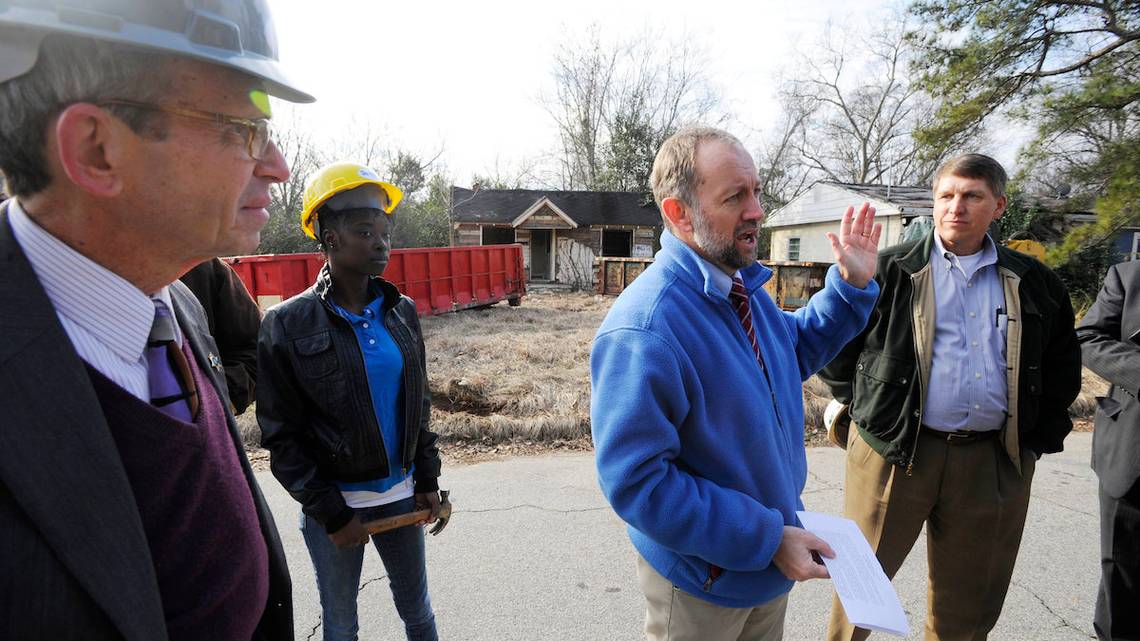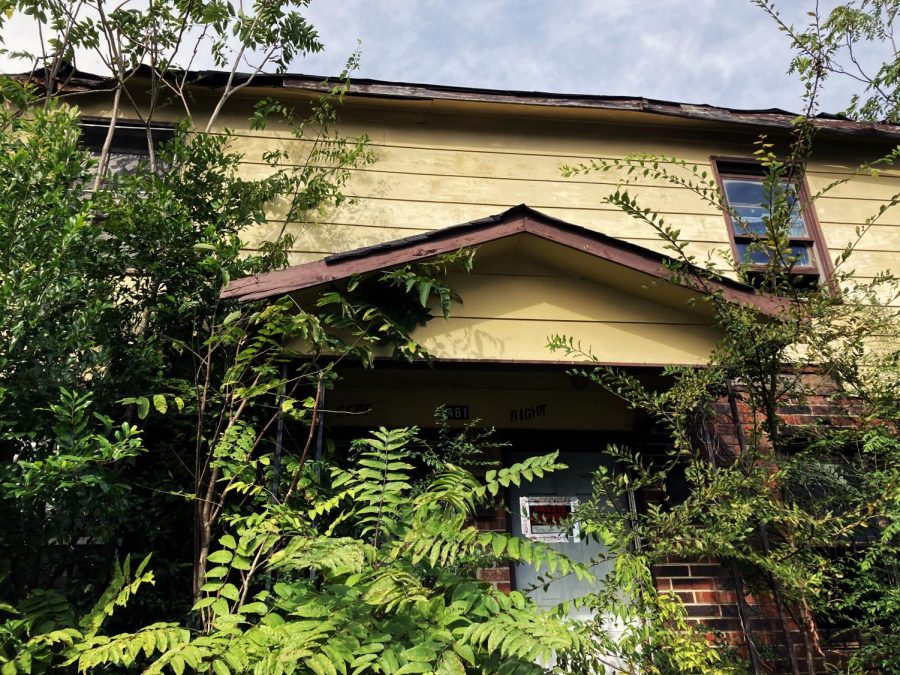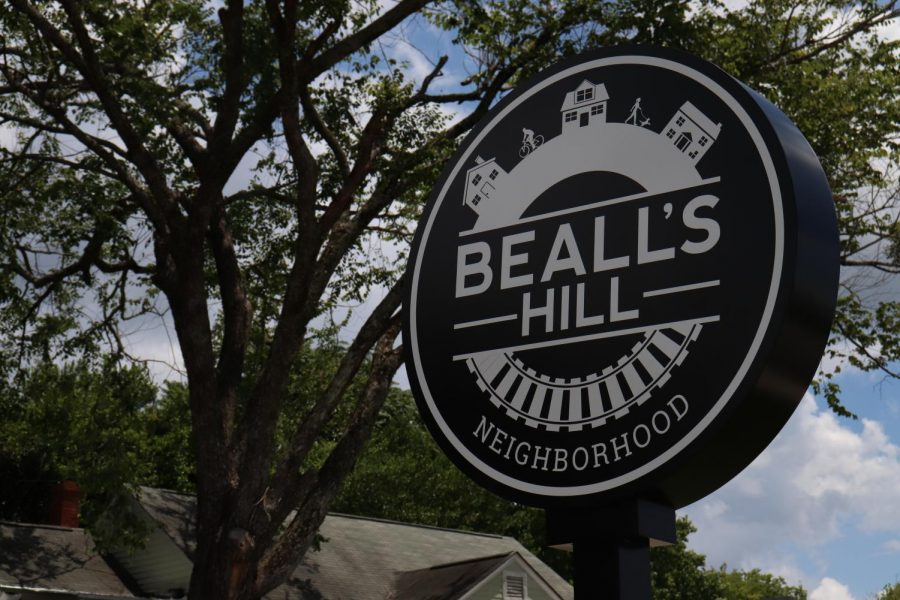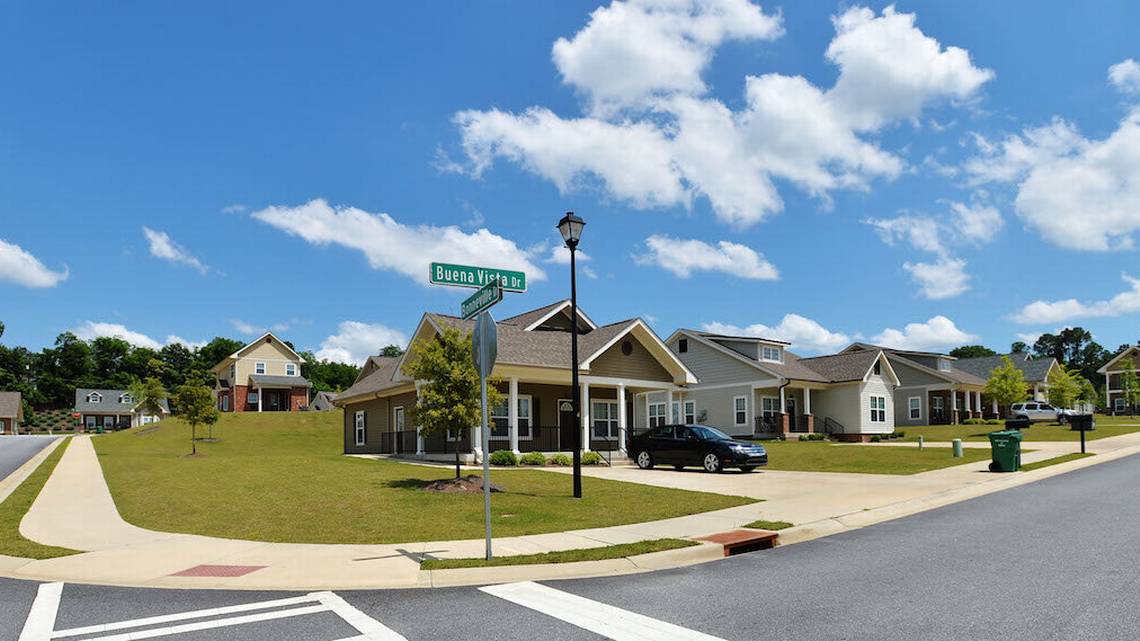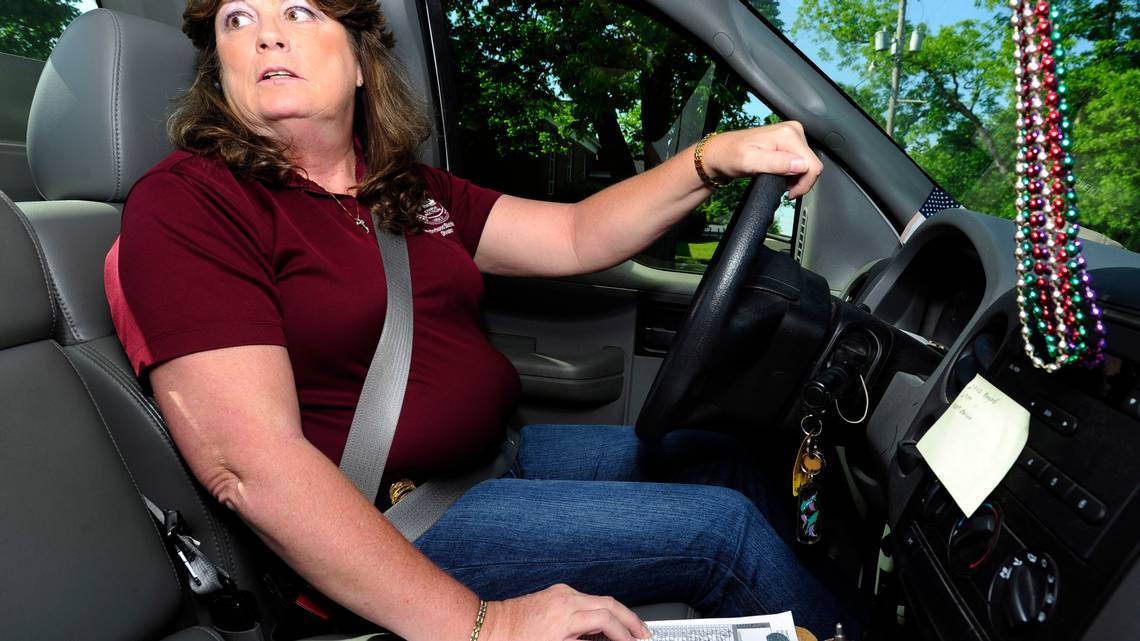Every government or nonprofit group that hopes to improve Macon Irving character, inevitably faces the same choice, shotgun or laser?
Efforts can be dispersed across the entire city or concentrated in one specific area.
The Lynmore Estates neighborhood is a prime example of what happens when an organization doubles down on the laser approach. In less than a decade, Macon Area Habitat for Humanity has replaced more than 10 percent of the chronically dilapidated community’s 399 properties with new, owner-occupied homes.
Giles O’Neal was chairman of the local Habitat board in 2005 when the Macon chapter of the international Christian housing charity went looking for one neighborhood where it could make a dramatic difference.
O’Neal’s role in developing that strategy was informed by his career as a property manager and real estate developer as well as his experience as a Macon city councilman in the early 1980s when he led the council’s Economic and Community Development committee.
“I didn’t see the real success in rebuilding a house here and going to mile away and doing and then skipping across town to do a third one in, “he said.
Indeed, interviews with dozens of people involved in Habitat’s work with Lynmore Estates and other revitalization projects across the city reveal a common sentiment: Macon’s urban and suburban blight problem is too big to be meaningfully addressed everywhere at the same time.
Lynmore Estates, O’Neal said, offered Habitat the perfect laboratory to experiment with the more concentrated approach.
The World War II-era residential development sprang up to house employees of the Macon Naval ordinance Plant and other nearby factories.
Within the southern tip of Macon’s urban sprawl, Lynmore Estates is compact with “definite boundaries,“ O’Neal said, recalling his first tours of the neighborhood with Habitat in 2005. Lynmore Estates is laid out in a rough triangle, confined by industrial development on its south side, railroad tracks to the west, a steep embankment followed by swamp on the east. It is between Houston Avenue and Broadway.
For Habitat’s leaders, the clear boundaries meant clear beginning and endpoints for their work, and the density meant that the fruits of their labor would be more noticeable to someone strolling the streets.
There’s one more reason more estates was an attractive target for O’Neal.
“A number of people not in Habitat but elsewhere said ‘Don’t touch it. It’s beyond hope. It’s a losing proposition,'” he recalled.
Habitat wanted to prove the naysayers wrong.
Transcending The Peach Orchard
For the roughly 2,000 residence of Lynmore Estates, their neighborhood’s nickname is fraught with conflicting memories.
The “Peach Orchard” is a ghost of an idyllic agrarian past. An old city planning document indicates there are actually were peach trees on the land as recently as the early 1940s, though even lifelong resident say they don’t remember ever seen them. Somewhere along the line, though, the nickname became a derogatory epithet that recalls the neighborhood’s darkest days of crime, drugs, and decay before Habitat came to town.
Christine Pearson moved into the second house Habitat built in Lynmore Estates in 2006 — though back then she had never heard of the place. Or so she thought.
“When I got my contract, my contract said ‘Lynmore Estates,’ and I was so excited,” Pearson recalled. “But when I got over here, I got real scared because I knew this was the Peach Orchard.”
Up until that moment, Pearson hadn’t understood that Lynmore Estates and the Peach Orchard were the same place. The realization gave her pause.
“The Peach Orchard made news every night, twice a night,” she said. “They was killing every night in the Peach Orchard.”
These days, some people still use the nickname. But in Habitat circles, it’s sometimes provokes dirty looks.
It may have been OK to say it at one time, but not anymore. That is, to a large extent, the doing of one woman: Sundra Woodford, Habitat’s neighborhood revitalization coordinator. Her job title serves as an indication of Habitat’s unique approach in Lynmore Estates.
The basic model of Habitat’s global organization revolves not around the community, but around the home. People in need apply for a new home and once selected, they work with Habitat and volunteers to build one. At the end of the process, Habitat sells the house to the occupant at no profit. The average price nationwide is $85,000 with a no-interest loan.
But Woodford’s job includes extending Habitat’ influence in Lynmore Estates beyond the homes and those who live in them.
“I serve as the conduit. I put all the resident in contact with the larger community resources to maintain and accomplish those neighborhood aspirations,” she said. Helping organize everything from neighborhood watches to pets sterilization campaigns Woodford finds money from government agencies and other nonprofits to make it all possible.
Much of the positive change in Lynmore Estates isn’t driven by Habitat but my residence themselves and two churches there: Southside Community Church and Countryside Baptist Church.
Woodford said she hopes neighborhood groups will increasingly take the lead, but she recognizes the necessity of outside help and funding much of which she obtains on their behalf.
Woodford also is an unofficial cheerleader scurrying from house to house trying to get residents to turn out for the next litter pick up day or community garden opening.
Providing “safe, decent affordable” housing remains Habitat’s chief mission said Harold Tessendorf, executive director of the Macon Area Habitat for Humanity. “But we realize that you can’t have safe, decent affordable housing in an environment where there isn’t neighborhood participation, where there isn’t good quality of life,” he said.
Adding Up The Problems
In the early days of Habitat’s involvement in Lynmore Estates, a series of exhausted focus groups with residence revealed broad consensus on what the primary deterrents to quality of life there are: blighted properties and uncontrolled animals. Neither problem is in Habitat’s wheelhouse, but it is taking them on nonetheless.
In February, Woodford partnered with several animal rescue organizations to conduct a canine census. Volunteers went door-to-door, counting dogs and noting whether they were spayed or neutered, whether they were fenced in, and whether they appeared well cared for.
The population that census takers directly observed came in at 246 dogs, though that number does not include the scores of stray or feral animals that roam the neighborhood in packs. Based on the assumption that sterilizing domestic dogs will diminish the number of wild ones over time, Habitat is bringing a spay-neuter van from Atlanta to serve the neighborhood this fall.
Like the animal issues, Habitat’s approach to the blight problem begin with a census of sorts. Last fall, students enrolled in a course title “Christian Ethics” at Mercer University helped conduct a house-by-house assessment of each property in Lynmore Estates s to distinguish those that are poorly maintained from those that are truly abandoned.
The product of that effort is a spreadsheet that has grown to include 129 empty properties, each listed with its owner’s name and address. About half are owned by out-of-towners, including a bank in Texas. an industrial supply company in Decatur, a Hasidic Temple in Hawaii, and various holding companies.
The legal process of trying to find these owners — inevitably failing to locate many of them — eventually gaining the title and eventually demolishing the property is long and expensive. It costs the Macon-Bibb county government $12,000 to $15,000 each, on average, Mayor Robert Reichert says.
Habitat has been involved in the demolition of more than 30 Lynmore Estates properties since 2005, but mostly in the context of clearing the lot to make room for a new Habitat house to be built there. However, as Habitat leaders began to contemplate the endgame of the hyper-focused initiative in the neighborhood, they’re starting to look at demolition as an end unto itself.
‘Blight Out Of Sight’
When Habitat first came to Lynmore Estates, 25 percent of the housing stock was owner-occupied. About 30 percent was vacant. The rest was rental property.
Now, with the addition of 43 Habitat homes, the owner occupied rate is about 36 percent, but the vacancy rate essentially remains unchanged.
“We probably need a home ownership rate of 50 percent plus,” Tessendorf said, arguing that majority own occupancy would be a key indicator that the neighborhood has “turned the corner.”
But there are multiple ways to achieve that proportion. If Habitat keeps building houses at its current rate, every property in Lynmore Estates would be replaced with a Habitat house by the year 2088, which is 74 years from now. That is not in the cards.
Macon Area Habitat’s board, while not pushing for an end just yet, is putting pressure on Tessendorf and his staff to start thinking about how they can wrap up their work in Lynmore Estates and eventually move on to another neighborhood.
They likely don’t have time to build their way to a 50 percent ownership rate, but they might be able to demolish their way there.
“If we can significantly reduce the number of blighted housing units that are out there, you’ve changed the ownership ratio in a big way,“ Tessendorf said.
Thus the idea for Habitat’s ‘Blight Out of Sight’ campaign was born. It’s an ambitious plan to demolish 83 vacant structures in Lynmore Estates by the year 2018 — that’s the end of Habitat’s current five-year strategic planning interval. The goal, if realized with the help of donors and local government, will put the neighborhoods homeownership rate above 50 percent, even if Habitat doesn’t add a single new homeowner between now and then.
The campaign launched in January with the demolition of two houses, including one that 11 year-old Rebecca McIntosh lives next to.
“Snakes and rats are always coming from that way,” she said, pointing to the slumping heap of a house that looked half demolished before the track hoe operator took his first swing. “We hate ’em.”
Rebecca’s mother, Sharon McIntosh, stood by and watched as the house started to crumple. Asked if she had noticed Habitat’s efforts to improve the neighborhood she’s lived in for 13 years, she said, “Oh yes, it’s been a better change for the community and a lot more better neighbors.”
That sentiment is common among Lynmore Estates residence and reveals a challenge that Habitat faces as it shifts to include more demolitions. Neighbors appreciate the Habitat homes, primarily because they’re bringing great neighbors — handpicked owner-occupiers with an investment in the community who faced deed restrictions that discourage re-selling until their mortgage is paid off.
The lot next to the McIntosh family now has a Habitat house on it. But as Habitat starts to demolish houses faster than it builds them, many lots will be left vacant.
During town hall meetings in east Macon and the College Hill Corridor this year organized by The Telegraph, Georgia Public Broadcasting and Mercer University, one of the most common sentiments expressed was that vacant lots are sometimes worse than the blighted properties that used to be there. Empty lots tend to become legal dumping grounds for trash, those attending the meeting said.
Habitat has been watching that problem closely as the Macon-Bibb government and formerly, the Macon city government has pursued a goal in recent years of demolishing 100 blighted structures annually. Few of those buildings have yet to be replaced with new construction.
The solution that Habitat leaders are contemplating reflects former mayor C. Jack Ellis, among others, has said would be a necessary step in order to rid the city of blight: Its total footprint of developed land must shrink.
Smaller, Better Neighborhood
The driving force behind the number of vacant properties in Lynmore Estates has been population loss. And while Macon-Bibb at large has suffered only slight net population loss over the years, significant migration within its borders has left acres upon acres of empty buildings and houses.
Filling them up would require a significant boost in population. Long-term demographic trends indicate that it is not likely for Macon or for Lynmore Estates. Therefore, Habitat leaders are starting to talk seriously with residents about how they could shrink the neighborhood down to size.
“There’s a clear indication that the core of the neighborhood is going to be housing,” Tessendorf said, adding that there is the potential to convert at least some properties near the core into green space or playgrounds.
But then there are the outer bands of the neighborhood, most significantly Worsham Avenue. The longest street in Lynmore Estates runs parallel to the railroad tracks that form the neighborhood’s western border. More than a third of the blighted properties in Lynmore Estates are on Worsham.
The concentrated vacancy along the more west side poses– and presents an opportunity — for Habitat: “ What do we put back there? Does it become housing? Or are there some other uses that we need to put it towards? “ Tessendorf asked.
Wary of speaking out of turn for neighborhood residents, Tessendorf expressed his idea in the form of of a rhetorical question. But what he and Habitat leaders are contemplating is slowly shrinking the borders of Lynmoore Estates by returning lots on its outskirts to nature or something close to nature.
On the neighborhood’s southern border, a community peach orchard is taking shape at 722 Shi Place, with an inaugural three trees that were planted during a ceremonial groundbreaking in July. Contemplating the prospect that at least some of the Peach Orchard is reverting to actual peach orchard, Tessendorf said “the circle of irony is complete.”
‘God, You’re turning It Around’
Whenever Woodford takes someone on a tour of Lynmore Estates, she always asked the same question, “Can you tell the Habitat homes apart from the others?”
Right now, the answer is often yes. Homes built by Habitat and owned by the families who help build them are colorful and modest, but neat as a pin with well trimmed lawns and bushes. They stand in stark contrast to the sagging, weathered, facades and wild yards often seen next door or down the street.
Changing that contrast would be an indication that Habitat has come close to finishing its work in Lynmore Estates, Woodford said.
“We want you to not be able to which ones are Habitat versus which ones were built by someone else,” she said.
Habitat leaders are starting to think about which neighborhood they might venture into next for a concentrated, years-long renewal effort. Since they’ve been in Lynmore Estates, the laser-focused approach on one neighborhood at a time has become popular with some other Habitat chapters across the country, notably in Fresno, California, where Habitat’s work in the West Fresno neighborhood has won local acclaim.
O’Neal, the former chair of Macon Area Habitat’s board thinks the pleasant Hill neighborhood might be a good next target for the organization. It was actually his first choice back when he helped Habitat zero in on Lynmore Estates nearly a decade ago.
Tessendorf said he’s been thinking about taking on the community that it surrounds Habitat’s headquarters on Holt Avenue. The area now anchored by Central High School was once joined with the historic and thriving neighborhood off Huguenin Heights until it was cut off in the mid 20th century by Interstate 75.
Resident of the notoriously crime-ridden Village Green area in south Macon are already lobbying Habitat to pick their neighborhood next. Habitat leaders, cognizant that community involvement hasn’t always been easy to marshal in Lynmore Estates, see great potential advantages in working in the neighborhood that’s invited them with open arms.
In Lynmore Estates, residents acknowledge their neighborhood transformation is incomplete, but they’re thrilled with how far it’s come.
“It has changed so much,” said Benny Harrell, who has lived there 35 years. “Now you can go out and a neighbor will speak to you. They’ll talk to you. They’ll hug you.”
Before a recent neighborhood cleanup, Harrell led volunteers in prayer.
“There’s been so many things said Lord along time ago about how this city was, how this little part of town was. But God, you’re turning it around,“ Harrell said, drawing exclamations of “amen” from the diverse crowd of neighbors, church members, Mercer students and Habitat staff ready to spend the day picking up trash.
“Thank you for the people that are coming to help us. We appreciate it so much,” he said. “Thank you all for the new friends were meeting Lord.”



